Club crests and sponsor's logos/trademarks are the intellectual property of their respective
owners as are the photographs reproduced

Uruguay 1930

Low poly version

THE FOOTBALLS DURING THE FIFA WORLD CUP
T-SHAPE
The 1930 ball would have been a 12-piece construction similar to the illustration on the left, but in fact two balls were used in the final itself! This saw hosts Uruguay pitted against Argentina. There was a heated argument about which ball was to be used – the Uruguayan ball or the Argentinian ball. The ball from the hosts, Uruguay, was allegedly somewhat larger than that of Argentina, although, given that the required circumference of the ball has always been between 68 and 70cm, the difference should hardly have been noticeable. In the end, the only way to resolve the disagreement was for the teams to agree to use the Argentinian ball in the first half and the Uruguayan ball in the second half. Suffice to say that Argentina led 2-1 at half time and Uruguay won the game 4-2!
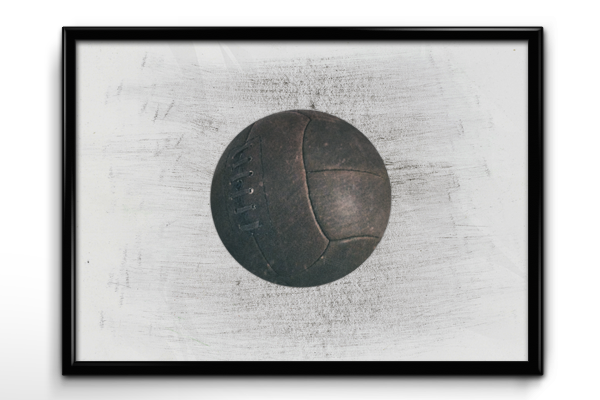
Italy 1934

Low poly version

THE FOOTBALLS DURING THE FIFA WORLD CUP
FEDERALE 102
The second FIFA World Cup found hosts Italy up against Czechoslovakia in the final. Eight minutes from the end, the Czechs were 1-0 up when Italy’s Orsi, receiving the ball from Guaita, ran through the Czech defence, feinted with his left foot but shot with his right. The ball swerved wildly for some reason and curled past the outstretched goalkeeper and into the net. Italy scored again in extra time to take the trophy. The following day, Orsi tried 20 times to repeat his ball-bending trick for the benefit of photographers and failed, even with an empty net! The ball would have been similar to the one illustrated here and it is possible that it may have become slightly distorted by the end of the match, which may have caused the swerve rather than being it entirely due to Orsi’s skill!

France 1938

Low poly version

THE FOOTBALLS DURING THE FIFA WORLD CUP
ALLEN
Cup-holders Italy this time faced the majestic Hungarians in the final in Paris. The Italians were dynamic, employing modern tactics that left the Hungarians looking static although they did manage to score two goals. Some fine midfield and wing play had put Italy 3-2 up when, ten minutes from the end, following some skilful interpassing, Biavati back-heeled a pass to centre-forward Piola, who smashed it into the goal to make it 4-2. France was at war a year later and there would be no more FIFA World Cups for 12 years. As in the two previous finals, the 12-panel ball would have come from local suppliers and would have been of brown leathe

Brazil 1950
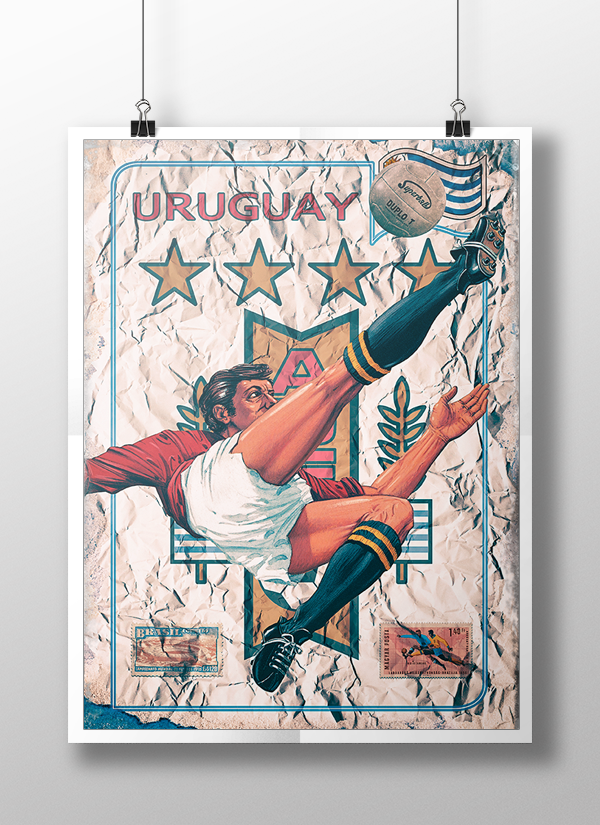
Low poly version

THE FOOTBALLS DURING THE FIFA WORLD CUP
SUPER DUPLO T
The first post-war finals in Brazil in 1950 still saw the use of the traditional 12-panel ball, but with curved edges to create less stress on the seams. Again, the balls used in the finals would have been made by a local manufacturer. This particular ball is from the legendary match in Belo Horizonte when the heavyweights of England played the United States. In those days, football or “soccer” was very much a minority sport in the USA and when the unfancied Americans beat the English 1-0, the entire football world was astounded. Such was the magnitude of the occasion that the ball was kept as a souvenir and it can now been see in the Soccer Hall of Fame in Oneonta, New York State, USA. For the record, in the final itself, the hosts Brazil were devastated to be beaten 2-1 by rivals Uruguay.
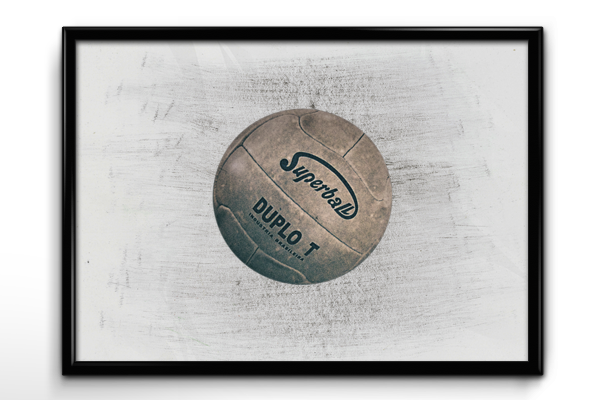
Switzerland 1954

Low poly version

THE FOOTBALLS DURING THE FIFA WORLD CUP
SWISS
Hungary were two goals up within eight minutes in the final in Berne, but remarkably Germany FR had equalised within another eight. Pouring rain drenched the players and the crowd during the game but German goalkeeper Turek was in fine form, making save after save on the slippery pitch. Five minutes from the end, Schaefer crossed the ball into a crowded goalmouth and it eventually reached Rahn, who controlled it, advanced, seemed to pause and then drove it past Hungarian goalkeeper Grosics with his left foot. Perhaps if Puskas, their great left-footed striker, had been fully fit Hungary might have won. The Magnificent Magyars lost only one match between 1950 and 1956, and that was the most important match of all. The 18-panel ball similar to the one illustrated left made its first appearance here and was used, in various forms, until 1966.

Sweden 1958

Low poly version

THE FOOTBALLS DURING THE FIFA WORLD CUP
TOP START
Just Fontaine of France set a tournament record of 13 goals in these finals, which still stands but nevertheless, it was Brazil and host nation Sweden who met in the final in Stockholm. Sweden surprisingly scored first but Garrincha swerved miraculously past two defenders and cut the ball back for Vava to score. Twenty minutes later, Vava scored again. Pelé, only 17, scored the third, trapping the ball on his thigh, hooking it over his head, swivelling and volleying past Svensson. For his second, he rose high above the defence to power in a majestic header. Brazil won 5-2 and were on their way towards becoming the world’s best football team with the man who would eventually be named as the world’s best-ever footballer. The 18-panel ball was designed with zig-zag interlocking seams so that there was less stress on the stitching.

Chile 1962

Low poly version

THE FOOTBALLS DURING THE FIFA WORLD CUP
CRACK
The balls used in Chile 1962 did not correspond at all with European standards. During wet weather, there were complaints that the balls were “drinking” water and were losing their colour in the sun. Indeed, before kick-off in the very first match between Chile and Switzerland, the referee, Ken Aston of England, asked to see the five balls that were to be used for the game. He was so horrified by their parlous, peeling state that he sent for a new ball, which only arrived ten minutes into the second half. Therefore, a number of European balls were quickly used as substitutes for the local brands for many of the remaining matches. In the final, champions Brazil met surprise finalists Czechoslovakia in Santiago. The Czechs scored first. They were supposed to be strong defensively but in this match it was their goalkeeper Schroif who was at fault for all the Brazilian goals. First he allowed Amarildo to put the ball between himself and the goalpost from a seemingly impossible angle, then he was out of position for the second – a header by Zito, and finally, he fumbled and dropped a hopeful cross from Djalma Santos and Vava happily pumped the ball into the net for the 3-1 win.
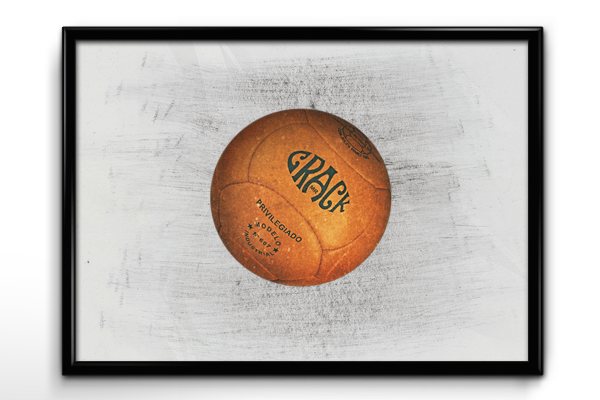
England 1966

Low poly version

THE FOOTBALLS DURING THE FIFA WORLD CUP
CHALLANGE
he FIFA World Cup was held in England in 1966 and The Football Association invited the top manufacturers to supply an unmarked ball each, from which the final choice would be made. Slazenger, a sports manufacturer based in Dewsbury in Yorkshire, was one of the chosen few. It was decided that Malcolm Wainwright, then 32, who had been making balls since he was 15 and was regarded as the firm’s best stitcher, would produce the sample ball. “I made about 20 balls all told,” he said. “They were 24-panel balls, which meant that there were six panels made up of three long strips of leather but the centre panels of these three strips had a further seam at right angles just to give more strength. I was asked to take extra care over them.” “They checked them for weight but then the manager would also check them over visually. Simply by using his eyes and his experience, he could tell see whether or not the shape was completely round and the seams were perfect. Anyway, he took the best one and sent it down to London.” The balls were laid out on a table in at FA headquarters in London. None were branded, but merely numbered, and were then examined by experts for circumference, loss of pressure, weight, bounce and so on. Happily for Slazenger, their ball was chosen. Wainwright and seven others were tasked with stitching the 300 balls needed for the 1966 FIFA World Cup. Each would have written his name inside the ball. This was normal practice for the stitchers because, before sewing the final seam, each ball went to a specialist for the bladder to be inserted and was then returned to the same man for the final seam to be sewn. An important point given that the stitchers were paid on piece work! The actual ball used in England’s 4-2 win over Germany FR in the 1966 final disappeared for many years. It should have gone to Geoff Hurst, the only man ever to score a hat-trick in a
FIFA World Cup final, but it ended up being taken by the West German player Helmut Haller,
whose son apparently kicked it about in his back garden for many years. It is now in the
National Football Museum in Preston in England and the only way to find out who made the
actual ball would be to unpick a seam and take a look at the name inside a tempting thought!

Mexico 1970

Low poly version

THE FOOTBALLS DURING THE FIFA WORLD CUP
TELESTAR
Mexico saw the dawn of a new era when adidas began its long-standing partnership with FIFA to supply footballs for all FIFA tournaments. It was also the first time a ball had been given a unique FIFA World Cup name appropriate to the time. “Telstar” was a small spherical communications satellite launched from Florida in 1962, but it probably became the most famous satellite of all time partly because of the pop instrumental of the same name, which was a worldwide hit for The Tornados. The 32-panel leather ball with white hexagons and black pentagons bore a strong resemblance to the satellite, which had a light background covered in dark panels. Many designs have superseded the “Telstar” but it still remains the definitive design used by artists, graphic designers and cartoonists when they want to illustrate a football. adidas delivered a mere 20 balls for use in the finals and sold an estimated 600,000 match balls and replica balls following the tournament. Brazil v. Italy matched attack against defence in the final. Brazil took the lead when Pelé rose high above the defence to score with a spectacular header. A careless back-heel from Clodoaldo let Italy back into the match but soon Gerson hit a low shot to make it 2-1. Jairzinho, the only player to score in every round, ran the ball into the net for a third and captain Carlos Alberto thundered in the fourth with a magnificent, powerful drive. Having won their third final, Brazil rightly claimed the Jules Rimet Trophy as their own.

Germany 1974

Low poly version

THE FOOTBALLS DURING THE FIFA WORLD CUP
TELESTAR Y CHILE DURLAST
The World Cup in Germany FR in 1974 saw a similar design called “Telstar Durlast”. In the final, the hosts were up against the world’s most talented team, the Netherlands. The great Johan Cruyff began the game sensationally with a run from one end of the pitch to the other without a German touching the ball until he was tripped by Hoeness. After scoring from the ensuing penalty, the Dutch, perhaps now overconfident, began to play the ball around the bemused Germans. But suddenly a penalty was awarded against them when Jansen tripped Breitner 1-1. Each team then bombarded the other’s goal until just before half time when Bonhof raced down the wing and crossed for Müller to seal the match with his 68th goal for his country ... and to allow that other great German player, Franz Beckenbauer, to lift the FIFA World Cup Trophy at the third attempt.
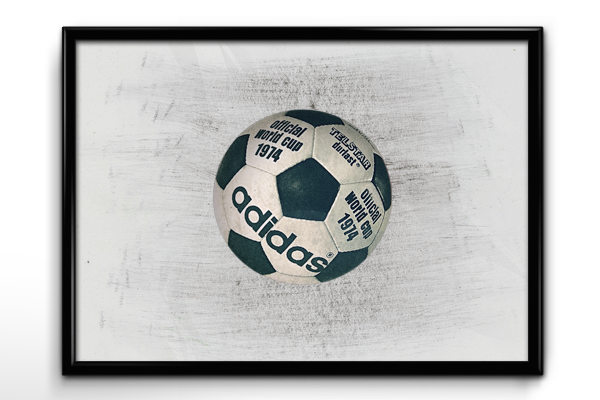
Argentina 1978

Low poly version

THE FOOTBALLS DURING THE FIFA WORLD CUP
TANGO RIVER PLATE
By this time, adidas were well into the pattern of choosing names appropriate for the host nation, so “Tango” was the name chosen for the ball used in Argentina in 1978. It was the first to feature the adidas trademark, which was a printed design of interconnected curved-edge triangles known as “triads”. The home team arrived five minutes late on the pitch for the final in Buenos Aires. This incensed the Dutch, who abandoned their “total football” for a more aggressive game, which was matched by Argentina. It was the ball control of Kempes that made the difference. His second goal was the best, and it came in extra time when he skipped past two defenders and the goalkeeper, beat two more defenders on the line and slotted the ball into the net. Luque scored the final goal to make it 3-1. The Netherlands had the world’s sympathy after losing their second consecutive final, but it was Argentina who lifted the cup in a storm of blue-and-white ticker tape.

Spain 1982

Low poly version

THE FOOTBALLS DURING THE FIFA WORLD CUP
TANGO ESPAÑA
The “Tango España” designed for Spain 1982 was the first to be made of a mix of real leather and synthetic material. It had a polyurethane coating to provide a more efficient water repellent. No one could accuse Italy of using their traditional defensive tactics in the final against Germany FR. Although they had one of the world’s finest-ever goalkeepers, 40-year-old Dino Zoff, their constant attack left the Germans outclassed. In the 59th minute, Paolo Rossi, who had already scored five goals in the previous two games, put Italy in the lead, diving to head home from a Gentile cross. Italy won 3-1 and missed a penalty to boot!

Mexico 1986

Low poly version

THE FOOTBALLS DURING THE FIFA WORLD CUP
AZTECA
The “Azteca” was a completely new model made of synthetic material in layers, each with different properties to give strength to the ball, help it retain its shape and be fully waterproof. This was also the first ball to feature a unique FIFA World Cup design the triads were based on an Aztec mural. The final was between a workmanlike Germany FR, coached by former captain Franz Beckenbauer, and an inspired Argentina. Argentina were 2-0 up in the second half and appeared to be coasting to victory, but German determination shone through not for the first time in a World Cup final and by the 82nd minute they had levelled the score. Willed on by the crowd, Argentina surged forward and captain Maradona sent a perfectly weighted pass into space for Burruchaga, who confidently slotted the ball past Schumacher to make it 3-2. Maradona did not score in the final itself but there was no doubt about who had now inherited the title of the world’s best player.

Italy 1990

Low poly version
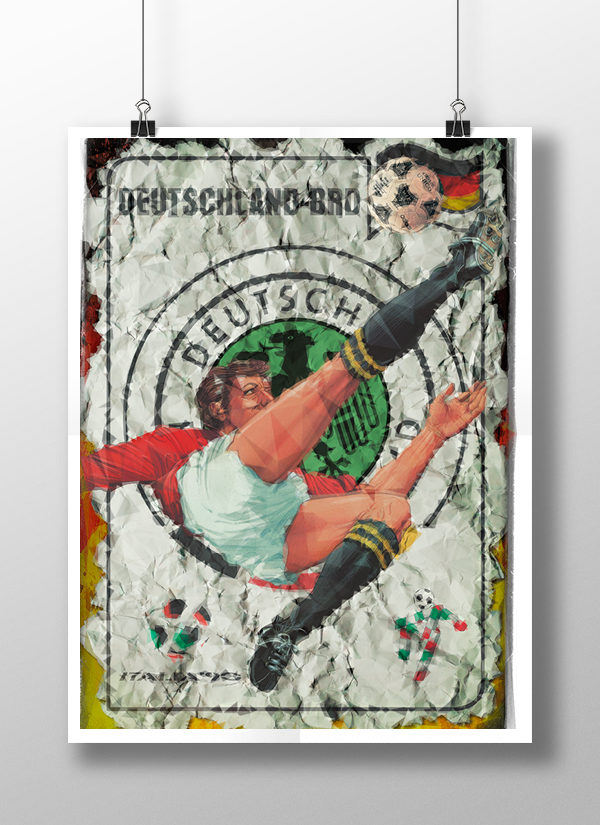
THE FOOTBALLS DURING THE FIFA WORLD CUP
ETRUSCO UNICO
The “Etrusco” triads featured an Etruscan lion within their design. The ball was again manufactured entirely from fully synthetic fibre layers, including one of latex to create stability and resistance to tearing, a layer of neoprene to make the ball water-tight and an outer skin of polyurethane for abrasion resistance and good rebound qualities. Argentina met Germany FR for the second World Cup running in the final. The only goal in a very poor game came from an 85th-minute penalty after Völler had been brought down in the area. Brehme’s spot kick won the match for the Germans. Two Argentinians were sent off Monzon for a tackle on Klinsmann and, in the 87th minute, Dezotti was shown the red card when he tried to wrestle the ball off Kohler, whom he considered was trying to waste time. Franz Beckenbauer became only the second man to win a World Cup both as a player and a manager.

Usa 1994

Low poly version

THE FOOTBALLS DURING THE FIFA WORLD CUP
QUESTRA
The ball was called the “Questra” to indicate the USA’s quest for the stars, so the shapes were incorporated into the triads. The ball itself was developed in France and then thoroughly tested by teams and players in both Europe and the USA. The ball was manufactured from five different materials with a final durable but flexible outer layer made from polyurethane. Brazil met Italy in the final a repeat of 1970. Brazil were unable to break down the Italian defence even though there were some near misses. Roberto Baggio had been Italy’s star striker in the earlier rounds, but he was suffering with a hamstring injury and was not at his best. At the end of 120 minutes, the score was 0-0. So for the first time, a World Cup final was decided on penalties. Brazil’s Marcio Santos missed, as did Baresi and Massaro for Italy. Up stepped Baggio to try and level the scores but he fired the ball straight over the top of Taffarel’s goal and Brazil had won their fourth FIFA World Cup.

France 1998

Low poly version

THE FOOTBALLS DURING THE FIFA WORLD CUP
TRICOLORE
The “Tricolore” used in 1998 was the first coloured ball to be designed for the FIFA World Cup. Its triads incorporated the symbols of the host nation, France, i.e. a cockerel, a high-speed train and a turbine. The ball itself was based on an entirely new synthetic material featuring “syntactic foam”, claiming to give better compression and more explosive rebound characteristics than its predecessor. The foam was made up of gas-filled micro-bubbles that distributed energy equally when the ball was kicked. This was the final that everyone had hoped for. The world champions against the home nation, but it was a strangely subdued Brazil who took the field, the crowd rife with rumours that there was a fitness problem with Brazil’s star player Ronaldo. France were determined to win on home territory, and they did so easily with two headed goals from their future World Player of the Year, Zinedine Zidane. Emmanuel Petit added a third to make it 3-0. So, at last France, the home of Jules Rimet, the creator of the FIFA World Cup and the team that had been an unlucky semi-finalist in both 1982 and 1986, had got their just deserts and the country partied the night away.

Korea/Japan 2002

Low poly version
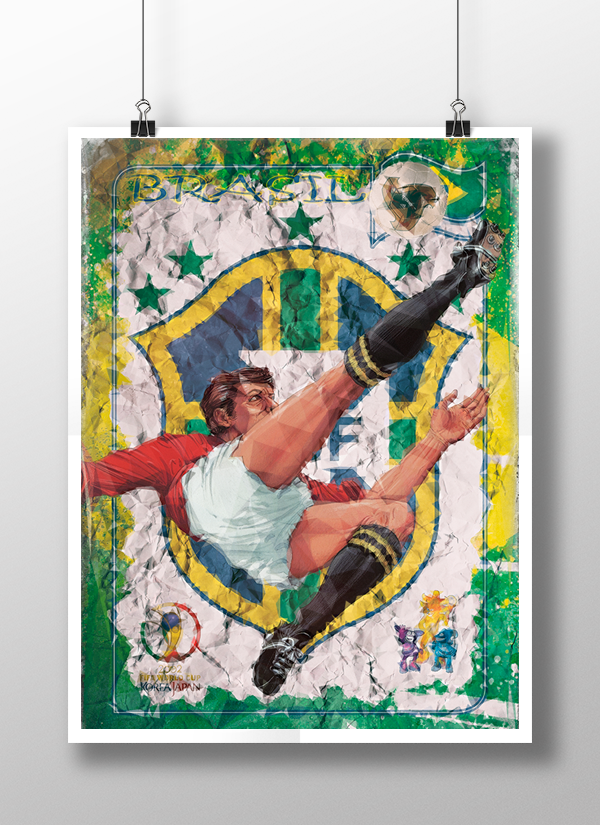
THE FOOTBALLS DURING THE FIFA WORLD CUP
FEVERNOVA
The ball for the FIFA World Cup Korea/Japan was known as the “Fevernova”. It was the result of three years of improvement on the “Tricolore” at the adidas research centre in Scheinfeld in southern Germany. The material consisted of six layers or coatings starting with a natural latex bladder inside, then a three-ply Raschel knitted fabric, syntactic foam, a polyurethane layer, a protected iriodine print and finally transparent polyurethane abrasion-resistant coating. The adidas triad design had now become two single, enlarged triads with the points turning into clockwise arrows in the colours of grey, red and gold. The background was no longer a traditional pure white but more of a champagne colour. Over 2,500 balls were supplied for the finals and an estimated six million of the high-quality match balls and replica-quality balls were sold worldwide. The final was between the two most successful FIFA World Cup nations of all time Brazil and Germany. Ronaldo’s two second-half goals gave Brazil their fifth FIFA World Cup title and firmly put the ghosts of the France ’98 final to rest. It was a hard-fought and equal match befitting a clash of two of world football’s titans, but Ronaldo had the touch of greatness that separated the two teams in Yokohama, Japan.

Germany 2006

Low poly version

THE FOOTBALLS DURING THE FIFA WORLD CUP
TEAMGEIST
More than three years of extensive research and development were needed to present the adidas +Teamgeist, the company’s best performing ball ever. Thanks to a revolutionary 14-panel ball configuration, players were able to show their true skills, as the quality and performance characteristics were identical every time they kicked the ball. The adidas Innovation Team (a.i.t) rigorously tested the new ball for the 2006 FIFA World Cup Germany, first under the toughest laboratory conditions possible, later also with professional players and clubs on the field of play. Scientific tests were conducted together with the Sports Technology Research Group of the University of Loughborough, one of the leading institutions of its kind worldwide. These tests confirmed that the adidas +Teamgeist was more round, precise and consistent than any top competitor’s match ball. Italy won their fourth world crown in Germany, beating France on penalties in Berlin. If Zinedine Zidane's red card was the final's defining image, Italy's triumph will be remembered as a team effort, with ten different Azzurri players finding the net during the course of the tournament.

South Africa 2010

Low poly version

THE FOOTBALLS DURING THE FIFA WORLD CUP
The adidas Jabulani, which means ‘to celebrate’ in isiZulu, was the official match ball of the 2010 FIFA World Cup and is already the 11th edition of adidas's FIFA World Cup balls. The 11 colours that are present on the Jabulani pay tribute to both football and the country in which Africa’s first-ever FIFA World Cup will be held.
Grip 'n' groove
Jabulani ushers in some major advances in football technology. The grip ’n’ groove’s profile circles twist around round the entire ball in an optimal aerodynamic way and the integrated grooves provide unmatched flight characteristics, making this the most stable and most accurate adidas ball ever.
Minimal seam, more perfection
As opposed to the flat-paneled molding of previous adidas footballs, Jabulani comprises eight thermally bonded 3D panels that have been, for the first time ever, spherically molded to make this ball a perfectly round football that is more accurate than everbefore.
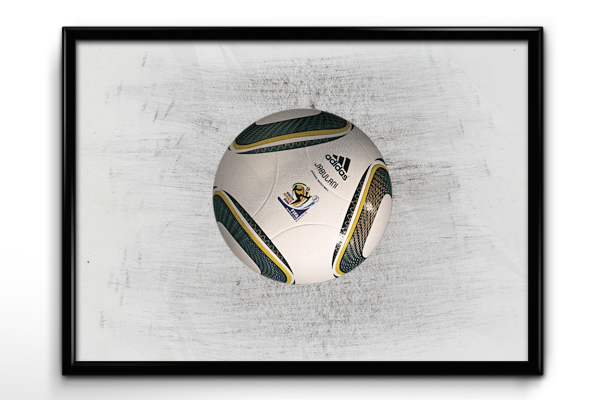
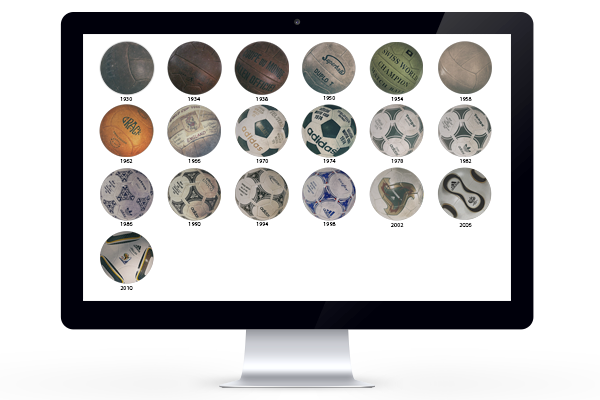
Serial

Thank you for watching !

